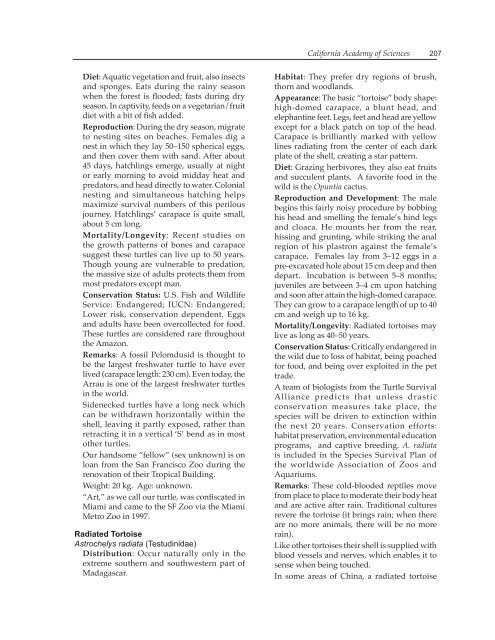THE STEINHART AQUARIUM - Gulf of Guinea Science ...
THE STEINHART AQUARIUM - Gulf of Guinea Science ...
THE STEINHART AQUARIUM - Gulf of Guinea Science ...
You also want an ePaper? Increase the reach of your titles
YUMPU automatically turns print PDFs into web optimized ePapers that Google loves.
Diet: Aquatic vegetation and fruit, also insects<br />
and sponges. Eats during the rainy season<br />
when the forest is flooded; fasts during dry<br />
season. In captivity, feeds on a vegetarian/fruit<br />
diet with a bit <strong>of</strong> fish added.<br />
Reproduction: During the dry season, migrate<br />
to nesting sites on beaches. Females dig a<br />
nest in which they lay 50–150 spherical eggs,<br />
and then cover them with sand. After about<br />
45 days, hatchlings emerge, usually at night<br />
or early morning to avoid midday heat and<br />
predators, and head directly to water. Colonial<br />
nesting and simultaneous hatching helps<br />
maximize survival numbers <strong>of</strong> this perilous<br />
journey. Hatchlings’ carapace is quite small,<br />
about 5 cm long.<br />
Mortality/Longevity: Recent studies on<br />
the growth patterns <strong>of</strong> bones and carapace<br />
suggest these turtles can live up to 50 years.<br />
Though young are vulnerable to predation,<br />
the massive size <strong>of</strong> adults protects them from<br />
most predators except man.<br />
Conservation Status: U.S. Fish and Wildlife<br />
Service: Endangered; IUCN: Endangered;<br />
Lower risk, conservation dependent. Eggs<br />
and adults have been overcollected for food.<br />
These turtles are considered rare throughout<br />
the Amazon.<br />
Remarks: A fossil Pelomdusid is thought to<br />
be the largest freshwater turtle to have ever<br />
lived (carapace length: 230 cm). Even today, the<br />
Arrau is one <strong>of</strong> the largest freshwater turtles<br />
in the world.<br />
Sidenecked turtles have a long neck which<br />
can be withdrawn horizontally within the<br />
shell, leaving it partly exposed, rather than<br />
retracting it in a vertical ‘S’ bend as in most<br />
other turtles.<br />
Our handsome “fellow” (sex unknown) is on<br />
loan from the San Francisco Zoo during the<br />
renovation <strong>of</strong> their Tropical Building.<br />
Weight: 20 kg. Age: unknown.<br />
“Art,” as we call our turtle, was confiscated in<br />
Miami and came to the SF Zoo via the Miami<br />
Metro Zoo in 1997.<br />
Radiated Tortoise<br />
Astrochelys radiata (Testudinidae)<br />
Distribution: Occur naturally only in the<br />
extreme southern and southwestern part <strong>of</strong><br />
Madagascar.<br />
California Academy <strong>of</strong> <strong>Science</strong>s<br />
207<br />
Habitat: They prefer dry regions <strong>of</strong> brush,<br />
thorn and woodlands.<br />
Appearance: The basic “tortoise” body shape:<br />
high-domed carapace, a blunt head, and<br />
elephantine feet. Legs, feet and head are yellow<br />
except for a black patch on top <strong>of</strong> the head.<br />
Carapace is brilliantly marked with yellow<br />
lines radiating from the center <strong>of</strong> each dark<br />
plate <strong>of</strong> the shell, creating a star pattern.<br />
Diet: Grazing herbivores, they also eat fruits<br />
and succulent plants. A favorite food in the<br />
wild is the Opuntia cactus.<br />
Reproduction and Development: The male<br />
begins this fairly noisy procedure by bobbing<br />
his head and smelling the female’s hind legs<br />
and cloaca. He mounts her from the rear,<br />
hissing and grunting, while striking the anal<br />
region <strong>of</strong> his plastron against the female’s<br />
carapace. Females lay from 3–12 eggs in a<br />
pre-excavated hole about 15 cm deep and then<br />
depart. Incubation is between 5–8 months;<br />
juveniles are between 3–4 cm upon hatching<br />
and soon after attain the high-domed carapace.<br />
They can grow to a carapace length <strong>of</strong> up to 40<br />
cm and weigh up to 16 kg.<br />
Mortality/Longevity: Radiated tortoises may<br />
live as long as 40–50 years.<br />
Conservation Status: Critically endangered in<br />
the wild due to loss <strong>of</strong> habitat, being poached<br />
for food, and being over exploited in the pet<br />
trade.<br />
A team <strong>of</strong> biologists from the Turtle Survival<br />
Alliance predicts that unless drastic<br />
conservation measures take place, the<br />
species will be driven to extinction within<br />
the next 20 years. Conservation efforts:<br />
habitat preservation, environmental education<br />
programs, and captive breeding. A. radiata<br />
is included in the Species Survival Plan <strong>of</strong><br />
the worldwide Association <strong>of</strong> Zoos and<br />
Aquariums.<br />
Remarks: These cold-blooded reptiles move<br />
from place to place to moderate their body heat<br />
and are active after rain. Traditional cultures<br />
revere the tortoise (it brings rain; when there<br />
are no more animals, there will be no more<br />
rain).<br />
Like other tortoises their shell is supplied with<br />
blood vessels and nerves, which enables it to<br />
sense when being touched.<br />
In some areas <strong>of</strong> China, a radiated tortoise


